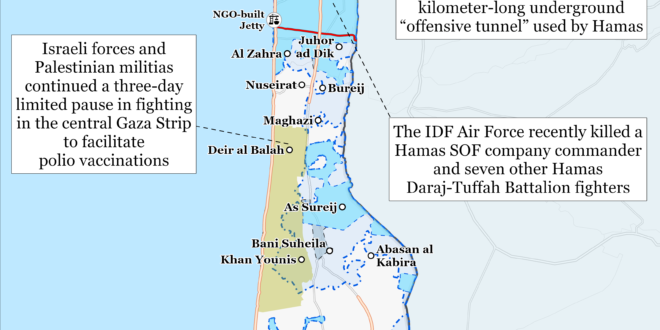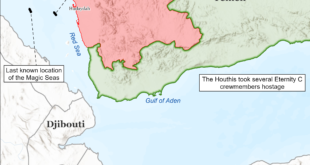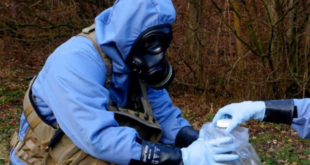Hamas has continued to exploit Israeli hostages in an information operation likely in order to increase pressure on Israel to accept a ceasefire-hostage agreement. Hamas likely calculates that this effort could create more favorable terms for Hamas in such an agreement while weakening the Israeli state. Hamas continued to insist on September 3 that Israel can only secure the release of living hostages through negotiations rather than military operations. Hamas released a propaganda video for the third time since recently killing six Israeli hostages. The most recent video—like the others—featured a recently executed Israeli hostage who called for a ceasefire-hostage agreement.[1] Hamas military spokesperson Abu Obeida separately blamed Israeli Prime Minister Benjamin Netanyahu directly for Hamas killing the six Israeli hostages.[2] Abu Obeida added that Hamas had issued new unspecified instructions for what its fighters who are guarding hostages should do if Israeli forces approach them.[3] Hamas released the hostage propaganda videos and Obeida’s comments in Arabic, English, and Hebrew, indicating that the messages are meant for Israeli, Palestinian, and Western audiences, among others.[4] These messages are meant to undermine domestic and international support for Israeli operations in the Gaza Strip and increase support for a ceasefire-hostage deal that meets Hamas’ demands. Senior Hamas official Mahmoud Mardawi told al Jazeera on September 3 that the release of Israeli hostages in Gaza will only occur through a prisoner exchange deal, which will only be achieved by a total Israeli withdrawal from the Netzarim and Philadelphi corridors.[5] The end of Israeli operations and a complete IDF withdrawal from the Gaza Strip has been one of Hamas’ principal demands since the beginning of negotiations and has since become the greatest hurdle to the talks.[6]
Israeli Prime Minister Benjamin Netanyahu defended and reiterated his plans for a continued Israeli military presence along the Philadelphi Corridor during a press conference on September 3.[7] The press conference comes amid domestic pressure to reach a ceasefire-hostage agreement following Hamas’ execution of six Israeli hostages.[8] Netanyahu said that control of the Philadelphi Corridor is central to Israeli war aims.[9] Netanyahu argued that Israeli disengagement from the Philadelphi Corridor enabled Hamas to become a serious threat in the first place by allowing Hamas to smuggle engineering equipment and weapons into the Gaza Strip.[10] Netanyahu added that “the axis of evil needs the Philadelphi Corridor and, for the same reason, we must control it.”[11] Netanyahu lastly warned that international pressure would make it difficult for Israel to return militarily to the corridor if it withdrew.[12]
US White House National Security Communications Advisor John Kirby said on September 3 that Israel previously agreed to a US-outlined ceasefire-hostage proposal in May 2024 that required the IDF to withdraw from “all densely populated areas,” including around or adjacent to the Philadelphi Corridor.[13] Kirby said that this “essential element” had not changed in subsequent ceasefire-hostage negotiations.[14] Kirby’s comments are not necessarily inconsistent with Netanyahu’s promise to maintain control of the Philadelphi Corridor. Netanyahu has reportedly agreed to withdraw Israeli forces from a one- to two-kilometer section of the Philadelphi Corridor during the first phase of the proposed ceasefire-hostage deal.[15]
An outlet affiliated with the Islamic Revolutionary Guards Corps (IRGC) published on September 2 an analytical report examining the possible trajectories for fighting between Israel and Lebanese Hezbollah.[16] The report assessed that the most likely course of action in the coming months is a continuation of limited fighting around the Israel-Lebanon border. The report concluded that Israel is unlikely to launch a major military offensive into southern Lebanon due to:
Israeli forces being already stretched by militia activity in the Gaza Strip and West Bank;
The threat of an Iranian attack on Israel in retaliation for Israel killing Ismail Haniyeh;
Internal divisions within the Israeli government; and
The United States opposing an all-out war ahead of its presidential election.
The report ignored the repeated statements from senior Israeli officials vowing to drive Hezbollah forces out of southern Lebanon in accordance with UN Security Council Resolution 1701, which ended the Israel-Lebanon War in 2006.[17]
It is unclear to what extent this report reflects Iranian leaders’ thinking about attacking Israel while deterring Israel from launching an offensive into Lebanon. The report nevertheless suggests that at least some in the Iranian security establishment are considering how the threat of an attack on Israel could shape Israeli decision-making vis-a-vis Hezbollah. Iran has repeatedly signaled its opposition to an Israeli offensive against Hezbollah in Lebanon.[18] Iran relies on Hezbollah to establish deterrence vis-a-vis Israel and to project force and influence throughout the Levant. Hezbollah has also adopted an increasingly prominent role in helping Iran manage the Axis of Resistance in recent years.
Some of the missiles that Iran fired in its large-scale attack on Israel in April 2024 were much less accurate than previously understood, according to a report by the Associated Press.[19] The report cited experts from the James Martin Center for Nonproliferation Studies. The report found that some of the Emad medium-range ballistic missiles that Iran used had a circular error probable of around 1.2 kilometers.[20] The circular error probable is a measurement of the median error radius of a weapon system. Tehran previously advertised that the Emad missile has a circular error probable of 50 meters, while international observers estimated that it was closer to 500 meters.[21] Both measurements suggest a much greater degree of accuracy than demonstrated in the Iranian April 2024 attack on Israel. Analysts at the James Martin Center for Nonproliferation Studies assessed that Iran tried to strike Israeli F-35I fighter jet hangars at the Nevatim airbase with the Emad missiles.[22]
Iran using Emad missiles in another attack on Israel would increase the risk of an all-out war erupting against Israel and even the United States. The inaccuracy of these missiles would risk causing severe collateral damage, including civilian casualties, even if Iran does not intentionally target civilian areas in Israel.[23] Iranian military commanders have reportedly considered attacking military targets around Haifa and Tel Aviv, where the risk of harming civilians would be particularly high given the population density.[24]
Key Takeaways:
- Israel-Hamas ceasefire-hostage negotiations: Hamas has continued to exploit Israeli hostages in an information operation to increase pressure on Israel to accept a ceasefire-hostage agreement. Hamas likely calculates that this effort could create more favorable terms for Hamas in such an agreement.
- Gaza Strip: Israeli Prime Minister Benjamin Netanyahu defended and reiterated his plans for a continued Israeli military presence along the Philadelphi Corridor that separates Egypt from the Gaza Strip. Netanyahu said that controlling the corridor is central to Israeli war aims and that withdrawing from the corridor would make it hard for Israel to ever return.
- Lebanon: An IRGC-affiliated outlet published an analytical report examining possible trajectories for fighting between Israel and Lebanese Hezbollah. The report concluded that Israel is unlikely to launch a major military offensive into Lebanon for several reasons, including the imminent threat of an Iranian attack on Israel.
- Iran: Some of the missiles that Iran fired in its large-scale attack on Israel in April 2024 were much less accurate than previously understood. Iran using such missiles in another attack on Israel would increase the risk of an all-out war erupting against Israel and even the United States.
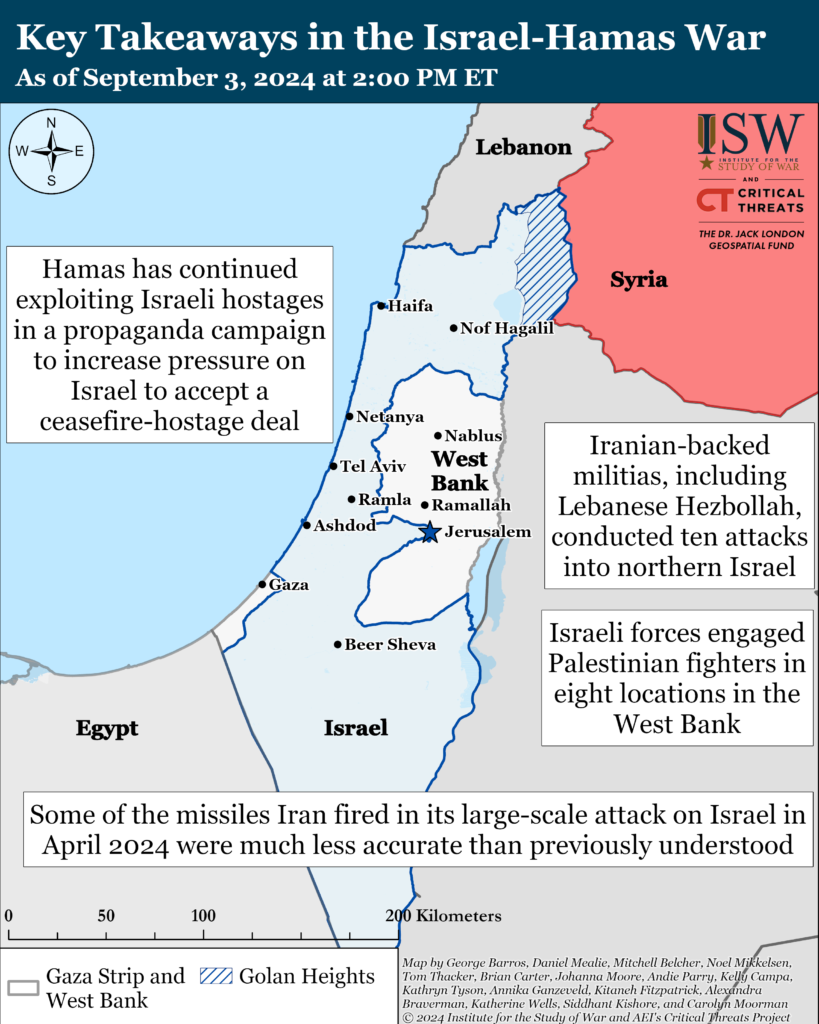
Gaza Strip
Axis of Resistance objectives:
Erode the will of the Israeli political establishment and public to sustain clearing operations in the Gaza Strip
Reestablish Hamas as the governing authority in the Gaza Strip
A humanitarian pause in fighting continued for a third day in the central Gaza Strip on September 3 to enable humanitarian aid groups to administer polio vaccines.[25] The Israeli Prime Minister’s Office has emphasized that the pause is not related to the longer-term ceasefire-hostage proposal currently under discussion in Doha.[26] Humanitarian aid groups have been administering the vaccines to Gazan children over three days during eight-hour humanitarian pauses in the central Gaza Strip.[27] UN officials said that health workers have vaccinated over 161,000 children in the central Gaza Strip since September 1.[28] Israel will also conduct pauses in three-day blocks in designated areas of the southern and northern Gaza Strip from September 4 to 9 to enable the vaccination campaign to proceed in those areas.[29]
Local Palestinian sources reported that the IDF continued limited military operations outside of the vaccination ceasefire zones in the Gaza Strip during the humanitarian pause on September 3. Palestinian sources reported small arms fire and shelling south of Gaza City, indicating that Israeli ground operations have continued in the northern Gaza Strip.[30] The IDF 252nd Division last acknowledged its operations in Gaza City on August 31.[31]
Israeli forces recently found and destroyed a kilometer-long underground “offensive tunnel” used by Hamas in Beit Lahiya.[32] The IDF Gaza Division, Northern Brigade and Yahalom combat engineers used prior intelligence to locate the tunnel, which stopped about 200 meters from the Israel-Gaza Strip border near Zikim.[33] Israeli forces searched the tunnel and located weapons, electronic infrastructure, and rail transport tracks likely meant to transport weapons and tunnel excavation materials.[34] The IDF stated that Israeli forces had demolished the tunnel in recent weeks.
The IDF Air Force struck a Hamas command-and-control site within a former school in Gaza City on September 3.[35] The IDF stated that Hamas used the site at the former Namaa College in Sheikh Radwan to plan and conduct attacks.[36] The IDF also stated that it took steps to reduce civilian harm, including through the use of specific munitions and aerial surveillance.[37] A Palestinian journalist reported that seven Palestinians were killed in the airstrike.[38]
Palestinian militias conducted at least one mortar attack targeting Israeli forces near the Netzarim Corridor, south of Gaza City, on September 3.[39]
The IDF Air Force struck a Hamas compound and killed a Hamas Nukhba special operations forces (SOF) company commander and seven other Hamas Daraj-Tuffah Battalion fighters in central Gaza City on September 3.[40] The IDF stated that it conducted an airstrike targeting a Hamas compound south of Daraj neighborhood in Gaza City. The IDF killed eight Hamas fighters from the Daraj and al Tuffah Battalion, including Ahmed Fawzi Nasser Mohammed Wadiyya, the commander of the Daraj-Tuffah Battalion’s Nukhba SOF company.[41] Wadiyya commanded the October 7 attacks on Netiv Ha’asara and participated directly in the attacks as a paraglider.[42] The strike also killed a Hamas fighter who specialized in engineering, explosives, and using anti-tank weapons and sniper rifles.[43] The IDF stated that the airstrike was conducted outside of al Ahli Hospital and that the IDF took steps to reduce civilian harm.[44]
Palestinian militias mortared Israeli forces near Salah ad Din Gate, east of Rafah City, on September 3.[45]
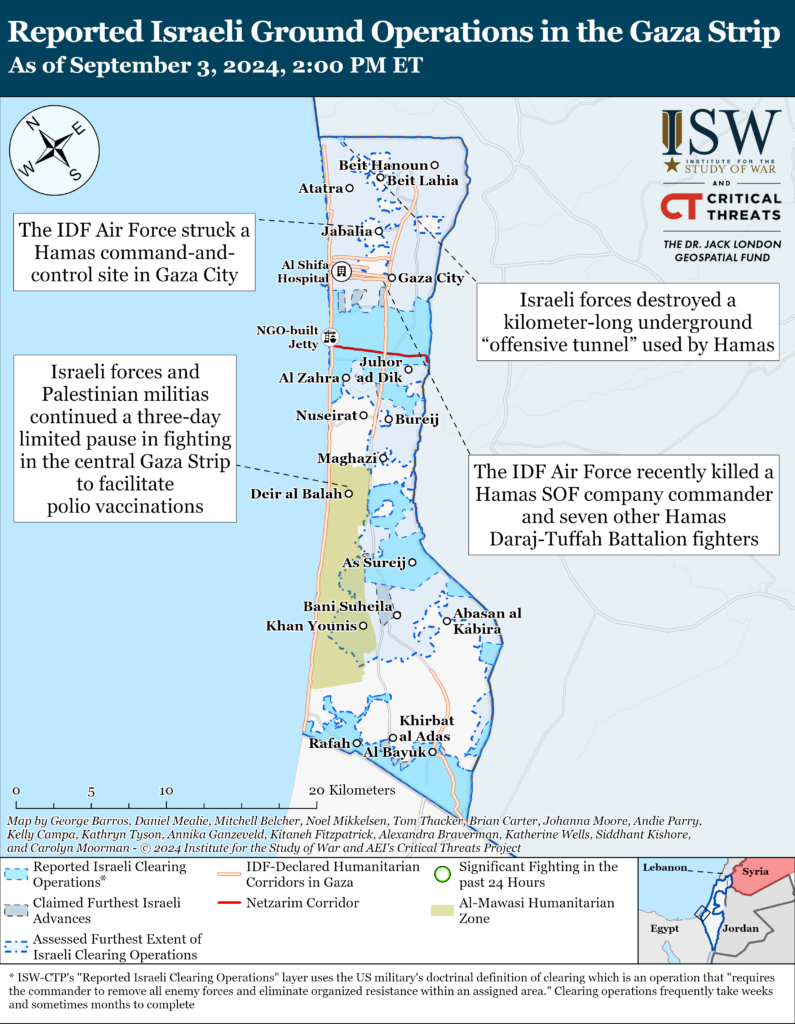
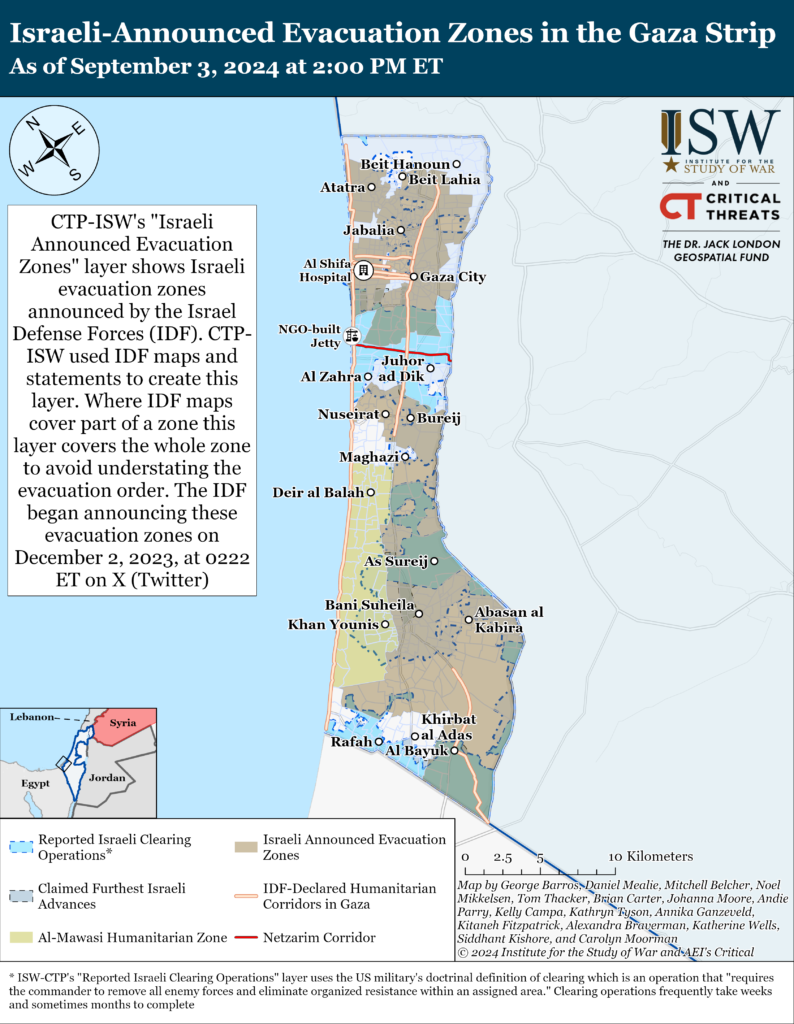
West Bank
Axis of Resistance objectives:
Establish the West Bank as a viable front against Israel
Israeli forces have engaged Palestinian fighters in eight locations in the West Bank since CTP-ISW’s last data cutoff on September 2.[46] Hamas, Palestinian Islamic Jihad, the al Aqsa Martyrs’ Brigades, and the Mujahidin Brigades fired small arms and detonated improvised explosive devices (IED) targeting Israeli forces in three areas in Tulkarm city.[47]
The IDF conducted an airstrike on September 2 targeting Palestinian fighters who fired small arms at Israeli forces in Tulkarm.[48] The al Aqsa Martyrs’ Brigades acknowledged the deaths of two Palestinian fighters who died while engaging Israeli forces in Tulkarm.[49] Hamas stated that Israeli forces have killed at least 30 Palestinian fighters in the West Bank since August 28 and called for Palestinian fighters to escalate attacks targeting Israeli civilians and soldiers in the West Bank.[50]
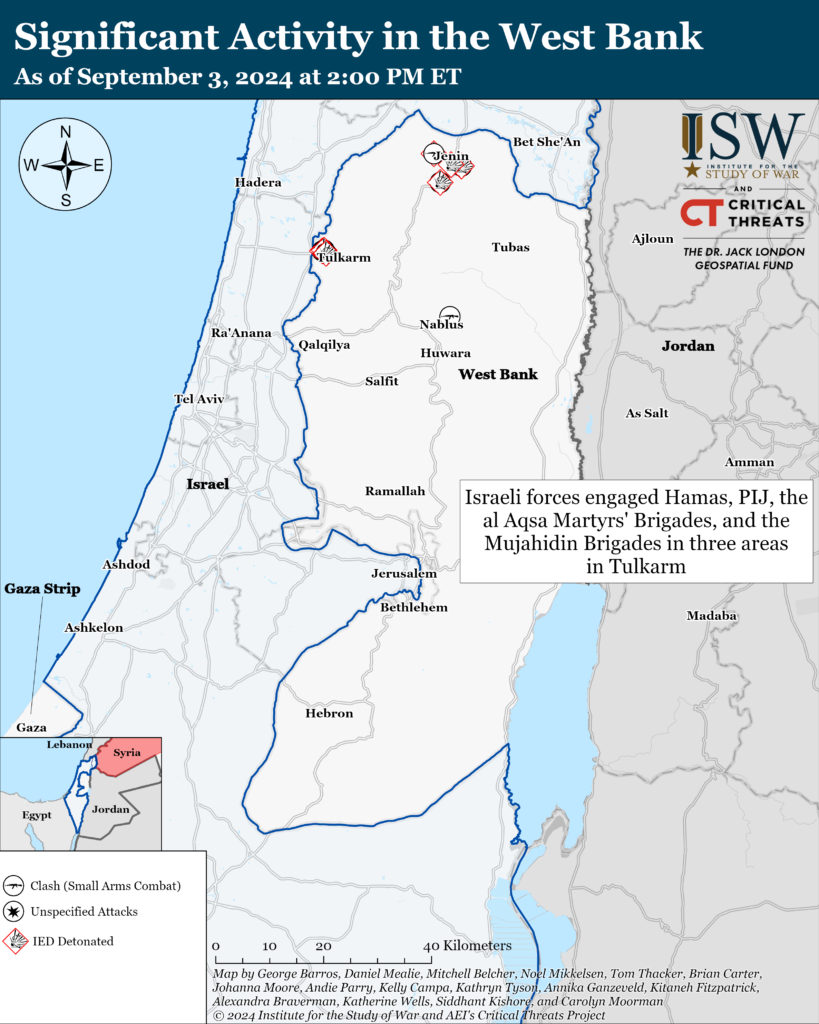
This map is not an exhaustive depiction of clashes and demonstrations in the West Bank.
Southern Lebanon and Golan Heights
Axis of Resistance objectives:
Deter Israel from conducting a ground operation into Lebanon
Prepare for an expanded and protracted conflict with Israel in the near term
Expel the United States from Syria
Iranian-backed militias, including Lebanese Hezbollah, have conducted at least ten attacks into northern Israel since CTP-ISW’s last data cutoff on September 2.[51]
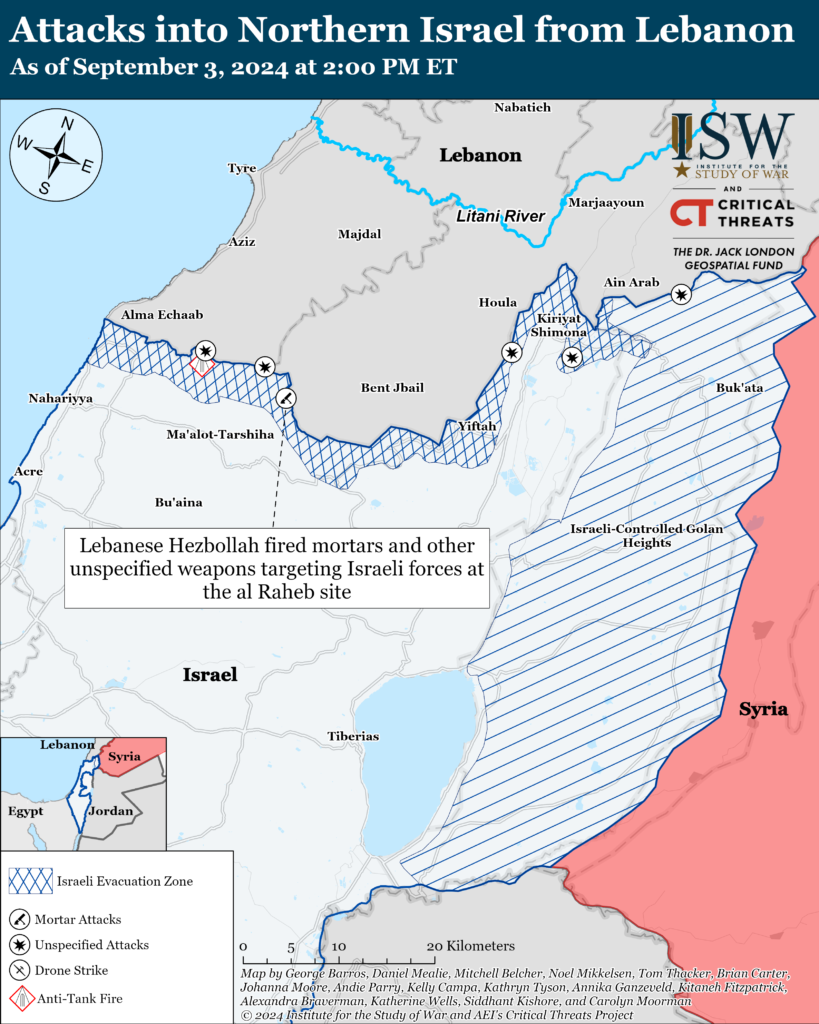
19 hours ago
Iran Update, September 3, 2024
Kelly Campa, Andie Parry, Alexandra Braverman, Kathryn Tyson, Katherine Wells, Carolyn Moorman, Ria Reddy, Johanna Moore and Nicholas Carl
TIP
x
Make a text selection to add comments
Information Cutoff: 2:00pm ET
The Iran Update provides insights into Iranian and Iranian-sponsored activities abroad that undermine regional stability and threaten US forces and interests. It also covers events and trends that affect the stability and decision-making of the Iranian regime. The Critical Threats Project (CTP) at the American Enterprise Institute and the Institute for the Study of War (ISW) provides these updates regularly based on regional events. Click here to see CTP and ISW’s interactive map of Israeli ground operations. This map is updated daily alongside the static maps present in this report.
CTP-ISW defines the “Axis of Resistance” as the unconventional alliance that Iran has cultivated in the Middle East since the Islamic Republic came to power in 1979. This transnational coalition is comprised of state, semi-state, and non-state actors that cooperate to secure their collective interests. Tehran considers itself to be both part of the alliance and its leader. Iran furnishes these groups with varying levels of financial, military, and political support in exchange for some degree of influence or control over their actions. Some are traditional proxies that are highly responsive to Iranian direction, while others are partners over which Iran exerts more limited influence. Members of the Axis of Resistance are united by their grand strategic objectives, which include eroding and eventually expelling American influence from the Middle East, destroying the Israeli state, or both. Pursuing these objectives and supporting the Axis of Resistance to those ends have become cornerstones of Iranian regional strategy.
We do not report in detail on war crimes because these activities are well-covered in Western media and do not directly affect the military operations we are assessing and forecasting. We utterly condemn violations of the laws of armed conflict and the Geneva Conventions and crimes against humanity even though we do not describe them in these reports.
Hamas has continued to exploit Israeli hostages in an information operation likely in order to increase pressure on Israel to accept a ceasefire-hostage agreement. Hamas likely calculates that this effort could create more favorable terms for Hamas in such an agreement while weakening the Israeli state. Hamas continued to insist on September 3 that Israel can only secure the release of living hostages through negotiations rather than military operations. Hamas released a propaganda video for the third time since recently killing six Israeli hostages. The most recent video—like the others—featured a recently executed Israeli hostage who called for a ceasefire-hostage agreement.[1] Hamas military spokesperson Abu Obeida separately blamed Israeli Prime Minister Benjamin Netanyahu directly for Hamas killing the six Israeli hostages.[2] Abu Obeida added that Hamas had issued new unspecified instructions for what its fighters who are guarding hostages should do if Israeli forces approach them.[3] Hamas released the hostage propaganda videos and Obeida’s comments in Arabic, English, and Hebrew, indicating that the messages are meant for Israeli, Palestinian, and Western audiences, among others.[4] These messages are meant to undermine domestic and international support for Israeli operations in the Gaza Strip and increase support for a ceasefire-hostage deal that meets Hamas’ demands. Senior Hamas official Mahmoud Mardawi told al Jazeera on September 3 that the release of Israeli hostages in Gaza will only occur through a prisoner exchange deal, which will only be achieved by a total Israeli withdrawal from the Netzarim and Philadelphi corridors.[5] The end of Israeli operations and a complete IDF withdrawal from the Gaza Strip has been one of Hamas’ principal demands since the beginning of negotiations and has since become the greatest hurdle to the talks.[6]
Israeli Prime Minister Benjamin Netanyahu defended and reiterated his plans for a continued Israeli military presence along the Philadelphi Corridor during a press conference on September 3.[7] The press conference comes amid domestic pressure to reach a ceasefire-hostage agreement following Hamas’ execution of six Israeli hostages.[8] Netanyahu said that control of the Philadelphi Corridor is central to Israeli war aims.[9] Netanyahu argued that Israeli disengagement from the Philadelphi Corridor enabled Hamas to become a serious threat in the first place by allowing Hamas to smuggle engineering equipment and weapons into the Gaza Strip.[10] Netanyahu added that “the axis of evil needs the Philadelphi Corridor and, for the same reason, we must control it.”[11] Netanyahu lastly warned that international pressure would make it difficult for Israel to return militarily to the corridor if it withdrew.[12]
US White House National Security Communications Advisor John Kirby said on September 3 that Israel previously agreed to a US-outlined ceasefire-hostage proposal in May 2024 that required the IDF to withdraw from “all densely populated areas,” including around or adjacent to the Philadelphi Corridor.[13] Kirby said that this “essential element” had not changed in subsequent ceasefire-hostage negotiations.[14] Kirby’s comments are not necessarily inconsistent with Netanyahu’s promise to maintain control of the Philadelphi Corridor. Netanyahu has reportedly agreed to withdraw Israeli forces from a one- to two-kilometer section of the Philadelphi Corridor during the first phase of the proposed ceasefire-hostage deal.[15]
An outlet affiliated with the Islamic Revolutionary Guards Corps (IRGC) published on September 2 an analytical report examining the possible trajectories for fighting between Israel and Lebanese Hezbollah.[16] The report assessed that the most likely course of action in the coming months is a continuation of limited fighting around the Israel-Lebanon border. The report concluded that Israel is unlikely to launch a major military offensive into southern Lebanon due to:
Israeli forces being already stretched by militia activity in the Gaza Strip and West Bank;
The threat of an Iranian attack on Israel in retaliation for Israel killing Ismail Haniyeh;
Internal divisions within the Israeli government; and
The United States opposing an all-out war ahead of its presidential election.
The report ignored the repeated statements from senior Israeli officials vowing to drive Hezbollah forces out of southern Lebanon in accordance with UN Security Council Resolution 1701, which ended the Israel-Lebanon War in 2006.[17]
It is unclear to what extent this report reflects Iranian leaders’ thinking about attacking Israel while deterring Israel from launching an offensive into Lebanon. The report nevertheless suggests that at least some in the Iranian security establishment are considering how the threat of an attack on Israel could shape Israeli decision-making vis-a-vis Hezbollah. Iran has repeatedly signaled its opposition to an Israeli offensive against Hezbollah in Lebanon.[18] Iran relies on Hezbollah to establish deterrence vis-a-vis Israel and to project force and influence throughout the Levant. Hezbollah has also adopted an increasingly prominent role in helping Iran manage the Axis of Resistance in recent years.
Some of the missiles that Iran fired in its large-scale attack on Israel in April 2024 were much less accurate than previously understood, according to a report by the Associated Press.[19] The report cited experts from the James Martin Center for Nonproliferation Studies. The report found that some of the Emad medium-range ballistic missiles that Iran used had a circular error probable of around 1.2 kilometers.[20] The circular error probable is a measurement of the median error radius of a weapon system. Tehran previously advertised that the Emad missile has a circular error probable of 50 meters, while international observers estimated that it was closer to 500 meters.[21] Both measurements suggest a much greater degree of accuracy than demonstrated in the Iranian April 2024 attack on Israel. Analysts at the James Martin Center for Nonproliferation Studies assessed that Iran tried to strike Israeli F-35I fighter jet hangars at the Nevatim airbase with the Emad missiles.[22]
Iran using Emad missiles in another attack on Israel would increase the risk of an all-out war erupting against Israel and even the United States. The inaccuracy of these missiles would risk causing severe collateral damage, including civilian casualties, even if Iran does not intentionally target civilian areas in Israel.[23] Iranian military commanders have reportedly considered attacking military targets around Haifa and Tel Aviv, where the risk of harming civilians would be particularly high given the population density.[24]
Key Takeaways:
Israel-Hamas ceasefire-hostage negotiations: Hamas has continued to exploit Israeli hostages in an information operation to increase pressure on Israel to accept a ceasefire-hostage agreement. Hamas likely calculates that this effort could create more favorable terms for Hamas in such an agreement.
Gaza Strip: Israeli Prime Minister Benjamin Netanyahu defended and reiterated his plans for a continued Israeli military presence along the Philadelphi Corridor that separates Egypt from the Gaza Strip. Netanyahu said that controlling the corridor is central to Israeli war aims and that withdrawing from the corridor would make it hard for Israel to ever return.
Lebanon: An IRGC-affiliated outlet published an analytical report examining possible trajectories for fighting between Israel and Lebanese Hezbollah. The report concluded that Israel is unlikely to launch a major military offensive into Lebanon for several reasons, including the imminent threat of an Iranian attack on Israel.
Iran: Some of the missiles that Iran fired in its large-scale attack on Israel in April 2024 were much less accurate than previously understood. Iran using such missiles in another attack on Israel would increase the risk of an all-out war erupting against Israel and even the United States.
Gaza Strip
Axis of Resistance objectives:
Erode the will of the Israeli political establishment and public to sustain clearing operations in the Gaza Strip
Reestablish Hamas as the governing authority in the Gaza Strip
A humanitarian pause in fighting continued for a third day in the central Gaza Strip on September 3 to enable humanitarian aid groups to administer polio vaccines.[25] The Israeli Prime Minister’s Office has emphasized that the pause is not related to the longer-term ceasefire-hostage proposal currently under discussion in Doha.[26] Humanitarian aid groups have been administering the vaccines to Gazan children over three days during eight-hour humanitarian pauses in the central Gaza Strip.[27] UN officials said that health workers have vaccinated over 161,000 children in the central Gaza Strip since September 1.[28] Israel will also conduct pauses in three-day blocks in designated areas of the southern and northern Gaza Strip from September 4 to 9 to enable the vaccination campaign to proceed in those areas.[29]
Local Palestinian sources reported that the IDF continued limited military operations outside of the vaccination ceasefire zones in the Gaza Strip during the humanitarian pause on September 3. Palestinian sources reported small arms fire and shelling south of Gaza City, indicating that Israeli ground operations have continued in the northern Gaza Strip.[30] The IDF 252nd Division last acknowledged its operations in Gaza City on August 31.[31]
Israeli forces recently found and destroyed a kilometer-long underground “offensive tunnel” used by Hamas in Beit Lahiya.[32] The IDF Gaza Division, Northern Brigade and Yahalom combat engineers used prior intelligence to locate the tunnel, which stopped about 200 meters from the Israel-Gaza Strip border near Zikim.[33] Israeli forces searched the tunnel and located weapons, electronic infrastructure, and rail transport tracks likely meant to transport weapons and tunnel excavation materials.[34] The IDF stated that Israeli forces had demolished the tunnel in recent weeks.
The IDF Air Force struck a Hamas command-and-control site within a former school in Gaza City on September 3.[35] The IDF stated that Hamas used the site at the former Namaa College in Sheikh Radwan to plan and conduct attacks.[36] The IDF also stated that it took steps to reduce civilian harm, including through the use of specific munitions and aerial surveillance.[37] A Palestinian journalist reported that seven Palestinians were killed in the airstrike.[38]
Palestinian militias conducted at least one mortar attack targeting Israeli forces near the Netzarim Corridor, south of Gaza City, on September 3.[39]
The IDF Air Force struck a Hamas compound and killed a Hamas Nukhba special operations forces (SOF) company commander and seven other Hamas Daraj-Tuffah Battalion fighters in central Gaza City on September 3.[40] The IDF stated that it conducted an airstrike targeting a Hamas compound south of Daraj neighborhood in Gaza City. The IDF killed eight Hamas fighters from the Daraj and al Tuffah Battalion, including Ahmed Fawzi Nasser Mohammed Wadiyya, the commander of the Daraj-Tuffah Battalion’s Nukhba SOF company.[41] Wadiyya commanded the October 7 attacks on Netiv Ha’asara and participated directly in the attacks as a paraglider.[42] The strike also killed a Hamas fighter who specialized in engineering, explosives, and using anti-tank weapons and sniper rifles.[43] The IDF stated that the airstrike was conducted outside of al Ahli Hospital and that the IDF took steps to reduce civilian harm.[44]
Palestinian militias mortared Israeli forces near Salah ad Din Gate, east of Rafah City, on September 3.[45]
West Bank
Axis of Resistance objectives:
Establish the West Bank as a viable front against Israel
Israeli forces have engaged Palestinian fighters in eight locations in the West Bank since CTP-ISW’s last data cutoff on September 2.[46] Hamas, Palestinian Islamic Jihad, the al Aqsa Martyrs’ Brigades, and the Mujahidin Brigades fired small arms and detonated improvised explosive devices (IED) targeting Israeli forces in three areas in Tulkarm city.[47]
The IDF conducted an airstrike on September 2 targeting Palestinian fighters who fired small arms at Israeli forces in Tulkarm.[48] The al Aqsa Martyrs’ Brigades acknowledged the deaths of two Palestinian fighters who died while engaging Israeli forces in Tulkarm.[49] Hamas stated that Israeli forces have killed at least 30 Palestinian fighters in the West Bank since August 28 and called for Palestinian fighters to escalate attacks targeting Israeli civilians and soldiers in the West Bank.[50]
This map is not an exhaustive depiction of clashes and demonstrations in the West Bank.
Southern Lebanon and Golan Heights
Axis of Resistance objectives:
Deter Israel from conducting a ground operation into Lebanon
Prepare for an expanded and protracted conflict with Israel in the near term
Expel the United States from Syria
Iranian-backed militias, including Lebanese Hezbollah, have conducted at least ten attacks into northern Israel since CTP-ISW’s last data cutoff on September 2.[51]
Iran and Axis of Resistance
An unspecified Iraqi Resistance Coordination Committee source confirmed previous reports that Iranian-backed Iraqi militias are intentionally obfuscating responsibility for their attacks to prevent US retaliatory strikes.[52] The Iraqi Resistance Coordination Committee is the coordinating body for the Islamic Resistance in Iraq and other Iranian-backed Iraqi militias. The unspecified Iraqi Resistance Coordination Committee source confirmed unverified local Syrian reports that an unspecified Iranian-backed Iraqi militias attacked US forces at Conoco Mission Support Site, Deir ez Zor Province, on August 29.[53] The source said that the Iranian-backed Iraqi militias are foregoing claiming attacks targeting US forces as part of a new approach to avoid US retaliatory strikes.[54] The source claimed that unspecified individuals may give the United States targeting information if the militias claim responsibility for those attacks. An anonymous Islamic Resistance in Iraq source told Lebanese outlet al Akhbar on August 12 that the Islamic Resistance in Iraq is developing “new mechanisms” for attacking Israel and US forces in Iraq and Syria including conducting operations under militias with unknown names, headquarters, and leaders.[55] Iranian-backed Iraqi militias have notably used facade groups to obscure their involvement in attacks and operations since 2020.[56] The United States conducted self-defense strikes targeting senior Iranian-backed Iraqi militia leadership and militia infrastructure in response to attacks on US forces in Iraq and Syria between October 2023 and January 2024.[57]
Iranian Foreign Affairs Ministry Senior Adviser for Policy Ali Asghar Khaji spoke to UN Special Envoy for Syria Geir Pedersen on September 3 to discuss the resumption of “targeted” talks between Syria and Turkey.[58] Khaji expressed his support for peace and stability between Syria and Turkey. Pedersen presented his plans for the resumption of Constitutional Commitee meetings.
US Central Command (CENTCOM) destroyed two Houthi missiles in Houthi-controlled territory in Yemen on September 2.[59] CENTCOM determined that the missile presented an imminent threat to US and coalition forces and merchant vessels in the area.
US Central Command (CENTCOM) confirmed two Houthi attacks on merchant vessels in the Red Sea on September 2.[60] CENTCOM confirmed that the Houthis launched two ballistic missiles and a one-way attack drone targeting Panamanian-flagged, Greek-operated Blue Lagoon I and the Saudi-flagged, owned, and operated Amjad on September 2, striking both vessels. UKMTO reported on September 2 that two unspecified projectiles struck the Blue Lagoon I 70 nautical miles northwest of al Saleef, Yemen.[61] Reuters citing unnamed sources reported that the Amjad was targeted by a one-way attack drone.[62] Houthi spokesperson Yahya Sarea claimed responsibility for the ballistic missile attack on the Blue Lagoon I on September 2, but Sarea did not comment on the drone attack on Amjad.[63] Amjad’s owner, Saudi-state shipping company Bahri, similarly denied allegations that the Amjad was targeted by the Houthis‘ one-way attack drone and claimed that the drone had hit a nearby tanker instead.[64]
Iranian Supreme Leader Ali Khamenei approved a recommendation by the Supreme Economic Coordination Council (SECC) to reallocate around 5.8 billion US dollars from the National Development Fund (NDF) to settle public debts to wheat farmers and truck drivers on September 1.[65] The SECC is chaired by Iranian President Masoud Pezeshkian, Parliament Speaker Mohammad Bagher Ghalibaf, and Judiciary Chief Gholam Hossein Mohseni Ejei. The SECC added that it will cut the NDF share of Iranian energy revenues from 40 percent to 20 percent by March 2025 to provide the government the funds it needs to manage economic crises. The NDF is a sovereign wealth fund established in 2010 to use Iranian energy revenues for ”productive investments” and to save these financial resources for future generations.[66] This proposal was reportedly presented by Pezeshkian to the rest of the SECC. It is noteworthy that the SECC was able to agree this major new policy so soon after Pezeshkian took office in July 2024, given the SECC’s historic issues with arriving at a consensus. Pezeshkian was similarly able to work with Ghalibaf to approve all of the presidential cabinet nominees on the first try, marking the first time that Parliament has done so since 2001.[67]
 Eurasia Press & News
Eurasia Press & News
